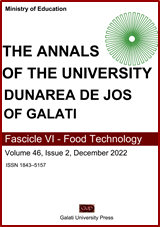Evaluation of bioactive compounds and antioxidant capacity of Romanian berries
Abstract
The objective of this paper was to evaluate seven different berries most consumed in Romania in order to determine the bioactive compounds: total phenolics content, total flavonoid content, total anthocyanins content, antioxidant activity by DPPH and total antioxidant capacity (water-soluble and lipid-soluble by photochemiluminescence assay, PCL). The analyzed fruits contain significant amounts of phenolic compounds between 18.91 and 383.06 mg gallic acid equivalents per 100 grams of fresh berries. Black currant extract had the highest content of total phenolic compounds, 383.06 mg GAE/100g, while the lowest level was obtained for the gooseberry, 18.91 mg GAE/100g. DPPH values varied between 22.15 and 892.35μmol Trolox Equivalent/100g fresh berries. Strong positive correlations between the antioxidant capacity of lipid-soluble compounds measured by PCL and DPPH was found (r= 0.9153). The results obtained demonstrated that different Romanian berries studied show a great antioxidant activity with possible benefits on human health.


